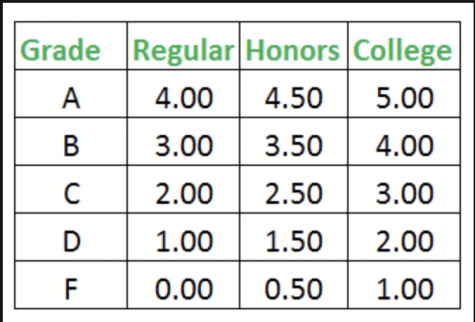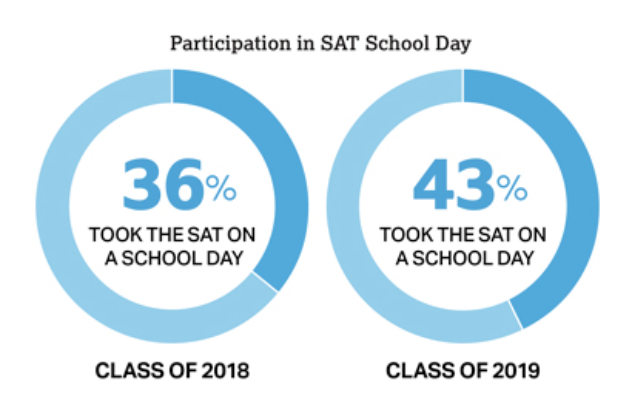Modern Society Quantifies Intelligence Over Character
This statistic shows how little students are taking the SAT in school, which is needed by almost all schools for admission. The fact that the test is not even being administered in a majority of schools is terrible for many students who do not have the resources to participate outside of school. Even though they have improved, there are many students who have to spend their own money and take a lot of time out of school to take the test when it should be provided as a basic right to college admission.
This is an opinion piece. Daniel Hellriegel is a Junior at Mendham High School. All of the views expressed in the following editorial are his own and do not necessarily reflect the views of the Patriot.
When applying to college, there are three main components that need to be considered by admissions offices: your GPA, your personal essay, and your standardized test scores. Two of the three categories are graded on a numerical scale, which is honestly one of the most ridiculous things that have integrated into society. Humans should not be defined by one or two numbers that have the power to determine their next four years. These numbers do not make us hireable or decent people, our character and morals do. The college admissions process should highlight these traits over test scores and grades.
The first obstacle to tackle in making the college admissions process humane is tackling the standardized testing problems, including both the SAT and the ACT. It is important to give credit when credit is due because a large amount of schools have opted to be test-optional. According to PrepScholar, over 900 schools are currently test-optional. This is a great resource for many students who do not increase their chances of admission with their test scores, but that does not change the fact that a majority of colleges in the United States are not test-optional. Pieces of the system do make sense, for instance, putting the test on one numbered system makes it easier to compare students against each other when they are all measured on one scale. But, the problem with standardized testing is the array of options that students of different backgrounds is so varied that it is difficult for underprivileged students to succeed. For instance, in the Mendham-Chester area, there are two different test prep centers that are very excellent in helping students improve their scores on tests like the SAT and the ACT. Since these centers are very successful in achieving their goal of increasing student preparedness and scores, many students also do not have access to these amenities for multitudes of reasons, anything from there not being accessible test prep centers within 40 minutes of somebody’s house, to parents not being able to afford expensive sessions or intensives to improve their student’s scores.
This also does not even touch upon the fact that students are able to prepare relentlessly for these tests. Some students have access to these test prep centers and work at them for hours, while other students, who might be objectively less intelligent but good test-takers, might excel much more on these tests than a student who might be smarter or have a better work ethic. This shows how the proposed numerical system is actually detrimental to students wanting to have access to higher-level colleges.
Additionally, the GPA measurement system is vague and useless. The Grade Point Average system is not measured on one scale, despite the perceived advantage that it ranks students across schools by class rigor and grades.. This system is notorious for being hard to measure, since “different schools have different methods of weighing GPAs” (Varsitytutors.com). This disadvantages many students who may have a worse grading system and they may have similar grades, but look worse. The complications inside the weighted GPAs are ridiculous. For instance, many students in different school districts have no access to AP or IB classes, which have a significant impact on weighted GPAs and benefit students who do have access to these classes. This means that two different students on the same intelligence level but one student has access to more classes will do so much better than the other student. But, that does not even begin to reveal the corruption that the GPA system holds and how terrible it actually is at measuring how students do in school. The numbers give a general idea of how students do in class, but once college admission people start to delve into more similar numbers, it becomes much more aware to students how chance will affect GPAs. For instance, the teaching and assessment styles of different teachers can have a serious impact on how well students do and their GPAs. Senior Lindsey Ingrey explained her perspective on this system, saying that GPAs are “subjective to the classes you take and the teachers you have, which makes it unfair because of different grading systems and other students might get a leg up over others. While teachers may try to compare grade averages and collaborate to level the playing field between different classes, there is always going to be some level of inequality simply due to the differences in teaching styles and grading and students’ responses to their classroom environments.” Therefore, it is extremely inaccurate for students to be measured on a GPA scale instead of their merits.

Overall, the college admissions process needs to make serious amends to their system so that it can be much more reflective of students’ capabilities and achievements during their high school careers. Leveling the playing field for many students would be seriously beneficial and make the system actually measurable of their abilities to succeed in different schools.

Daniel Hellriegel is an eleventh grader at West Morris Mendham High School. He is the Student Director of Mendham Players, a Peer Leader, and now a staff...






